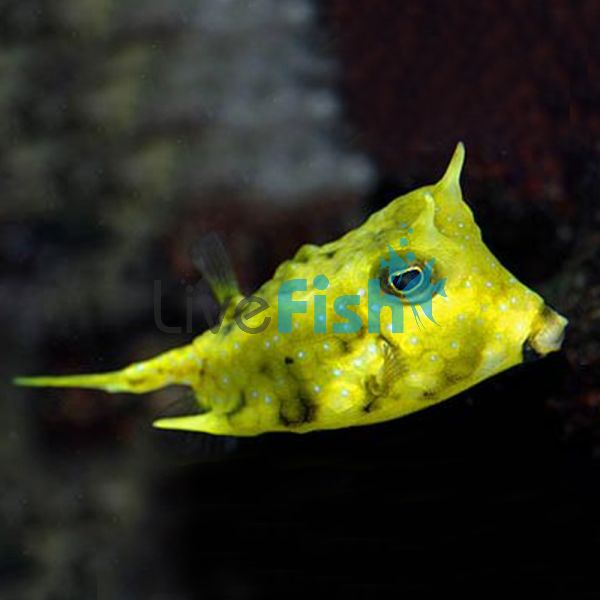Longhorn Boxfish - Medium
The Longhorn Boxfish is probably the most easily recognizable Boxfish. It is a hardy fish and easy to look after.
The Longhorn Boxfish is a unique addition to any aquarium, but care needs to be taken with regard to its toxins.
The Longhorn Boxfish has a peaceful temperament, but it does startle easily and if stressed can release ostracitoxin which is contained in its skin. It is capable of poisoning an aquarium, killing everything in it. The Longhorn Boxfish can be found on the East African coast and Red Sea, across to Indonesia and further East towards Japan.
The male and female Longhorn Boxfish have a pale, yellow body colour, covered with whitish or bluish spots. There are 2 small horns on the top of its head, and at the rear of its body. Life expectancy is around 8 years.
Reproduction involves a paired courtship around sunset. In the wild, a male will have several females within its territory. Eggs are released by the female which stay in the water table until they hatch and develop into juvenile boxfish.
Despite their peaceful temperament, the Longhorn Boxfish can be aggressive on occasion, but this is not consistent behavior. It is preferable to add the boxfish to an aquarium first and watch new arrivals, especially other Longhorn Boxfish.
In their natural habitat, Longhorn Boxfish are timid and will hide in corals or weeds if they encounter anything strange in the water (for instance divers). If there is nowhere to hide they may lay motionless on the floor. When the situation becomes too stressful they will start to develop black patches on their skin.
A full size adult can reach a length of 20 inches (50 centimeters).
Tank Recommendations for the Longhorn Boxfish
A tank at least 250 gallons (946 liters) is recommended.
Longhorn Boxfish are curious fish, but slow movers who do not like strong currents. They should be housed in a large tank with plenty of places to hide or shelter. If they are introduced to a reef tank, they will eat small invertebrates.
It is advised not to release any bag water into the tank when introducing a Longhorn Boxfish. If it is removed from the tank during a water change it needs to be kept alone in a separate container.
Suitable Tank Buddies
Longhorn Boxfish have a peaceful temperament and are best suited with fish who have similar behavior. Aggressive feeders may disrupt its eating habits.
The fact that they are capable of poisoning the aquarium means that extra care needs to be taken about their environment and tank buddies to make sure they aren’t harassed or stressed.
There is a possibility in a reef environment that certain corals will be nibbled, and smaller invertebrates are at risk of being eaten.
Usually Compatible
Longhorn Boxfish can be housed with a wide variety of fish including, Anthias, Blennies, Damsels, Gobies, Grunts/Sweetlips, Pseudochromis and Wrasse.
Sometime Compatible
Caution is advised when housing Longhorn Boxfish with members if their own species, Groupers, Hawkfish, Puffers, Triggers, and Invertebrates.
Rarely Compatible
Avoid housing Longhorn Boxfish with Seahorse/Pipefish and Sharks/Rays
Feeding Your Longhorn Boxfish
This species is omnivorous, and they are bottom feeders. They will consume a variety of meaty food and vegetables. Small invertebrates such as worms, mollusks, and clams are suitable, as well as algae. They are not fussy eaters, but they are slow feeders and should not be house with more aggressive eaters. It is recommended to feed Longhorn Boxfish 2 times per day.
| Scientific Name | Lactoria Cornuta |
|---|




